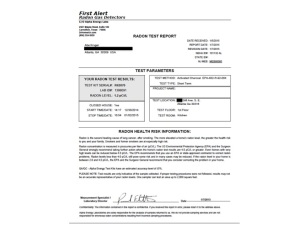Happy Radon Action Month!

The Environmental Protection Agency (EPA) has designated January as National Radon Action Month. Most people are surprised to learn that radon is the second leading cause of lung cancer in the US, after smoking; exposure to both radon and smoking multiplies the risk of developing lung cancer. Radon is a naturally occurring gas that forms from the breakdown of uranium in soil, rock and water. It is also colorless, odorless, and tasteless, making it impossible to detect without special equipment. The higher a home’s radon level, the greater the health risk to occupants. Radon can be found all over the US, and average levels are particularly high in the metro Atlanta region (Figure 1).

Figure 1. Georgia’s radon map. From http://www.epa.gov/radon/zonemap.html
It’s very important to test your home for radon. Radon levels can vary significantly from one home to next, even on the same block, since the geology of the individual site and the home’s construction impact the amount of radon in a home. This means that radon levels in your neighbor’s home don’t necessarily predict the levels you can expect in your own. To further complicate matters, you can’t test for radon until the home is complete, which is why it’s best to design the home minimize possible exposure in high-risk areas.
Before starting the renovation, I documented the existing conditions of the home as well as possible. This included tons of photographs, measuring the duct leakage in the heating and cooling system, measuring the home’s envelope leakage, and testing the home for radon. I’ll cover the duct and envelope leakage tests in future posts, but here I will discuss radon.
Testing for radon is pretty easy: you simply leave the test kit out for a couple of days in the lowest lived-in part of the home. I made sure to put the house in “winter time conditions” with all windows and doors closed and placed the activated charcoal test kit on the kitchen counter for 3 days. Then I just mailed the kit off to the lab and received the results via email. The price of most kits includes the lab fees, though shipping is separate.
Radon is measured in picocuries per liter of air (pCi/L) and my house had 1.2 pCi/L, which is below the US national average of 1.3 pCi/L. This is actually great news because the EPA and Surgeon General recommend action at 4.0 pCi/L.
Here are the action levels from the EPA:
≤ 2 pCi/L: no action required
2 pCi/L – 4 pCi/L: monitor the home by re-testing every 2 years
≥ 4 pCi/L: test again and/or take corrective action
So how does radon enter homes? In homes with basements or slabs, radon can enter through cracks in the concrete foundation. For homes with crawlspaces, radon can enter the crawlspace through exposed earth and then into the home through penetrations in the wood floor. To reduce radon levels you have to seal the pathways for the gas to enter the home and in extreme cases, you have to install a vent system to draw the radon away from the home.
Even though I wont be installing a radon vent system, I am encapsulating the crawlspace. Crawlspace encapsulation includes installing a sealed plastic liner over the earth and insulation on the walls. This should drastically reduce the amount of radon and other soil gases entering the home by preventing entry into the crawlspace. I’ll also retest the house once construction is substantially complete to confirm that the levels have not increased and hopefully decreased!
Additional Resources
- State Radon Program Contact Information – Find more information about the radon program in your area, including the availability of discounted radon test kits.
- Health Risks of Radon Exposure – Further information about the link between radon exposure and lung cancer.
- Consumer’s Guide to Radon Reduction – A guide to reducing radon levels in homes.



Hi Abe – I think it is important to clarify one point. Closed crawls have proven to actually increase radon levels inside the home in certain cases. A closed crawl is typically a semi-conditioned crawl which will essentially bring the crawl into the thermal envelope of the home thus increasing the amount of crawl space air that enters the home. It is important to clarify the drying mechanism for the crawl – exhaust only vs. a supply only or dehumidifier, etc as they will all have different results. This is especially true in a retrofit situation like you mentioned. Peter Yost has written about this extensively.
LikeLike
Hi Danny. Thanks for the feedback! I agree that crawlspace encapsulation can increase radon levels, but I think that’s quite rare or simply a symptom of improper encapsulation. Encapsulation has long been recommended as a radon mitigation strategy. The idea of increasing the connection between the home and crawlspace doesn’t really worry me as long as the crawlspace is properly encapsulated. I realize that’s a big “if” though! When radon can’t get into the crawl it then can’t get into the home. With all that said, perfect encapsulation is pretty challenging and I would always recommend radon testing after encapsulation if radon is a concern.
Also, I don’t think I’ve seen where Peter has presented specific examples of encapsulation causing an increase in radon levels. I’d be very interested to see that!
LikeLike